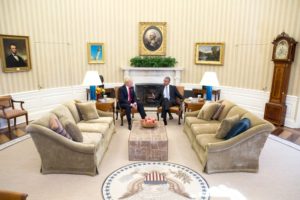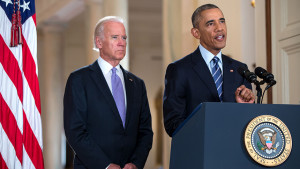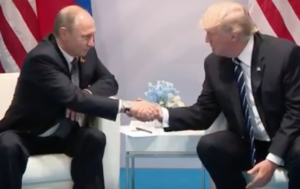How Obama, Trump Had Their Wings Clipped
Presidents Obama and Trump contrast sharply on foreign policy, but share a common denominator: they faced resistance to smoothing relations with a key power, Obama on Iran; Trump on Russia, Andrew Spannaus noted at Aspenia.
President Donald Trump was backed into a corner in late July, forced to sign a bill imposing new sanctions on Russia, despite opposing it on substance and form. Trump issued a signing statement, claiming that the new law impinges on “the President’s constitutional authority to recognize foreign governments” (referring to the case of Crimea and Ukraine), limits the President’s actions on sanctions, and violates “the President’s exclusive constitutional authority to determine the time, scope, and objectives of international negotiations”, among other things.

President Barack Obama meets with President-elect Donald Trump in the Oval Office, Nov. 10, 2016. (Official White House Photo by Pete Souza)
The overwhelming vote on the sanctions bill in both the House and the Senate (419-3 and 98-2, respectively) was a clear indicator of how much of official Washington sees the White House’s attempts to improve relations with Russia: as a dangerous goal that needs to be stopped as soon as possible, lest the apparently bumbling, self-absorbed and ineffective President actually succeed in implementing a major change in U.S. foreign policy, one with repercussions on numerous areas of global geopolitics.
Influential Republicans in the Senate such as John McCain and Lindsey Graham have never hidden their disdain for Trump’s anti-neocon positions, and now they find themselves with the almost unanimous support of their colleagues on the Democratic side of the aisle as well.
The constant churn of Russiagate scandals, although they have yet to turn up a smoking gun, has created an environment in which politicians and major press outlets have decided that Russia is Trump’s weak point, on which a strong defeat can neuter his effectiveness and potentially even lead to his impeachment.
The White House’s isolation on a point of foreign policy that would represent a major strategic shift recalls another situation not too many years ago, that of Iran, when then-President Barack Obama found himself in a difficult battle with the overwhelming majority of Congress apparently opposed to his plan to shift gears in the Middle East. Obama ultimately won that battle, succeeding in reaching a historic deal regarding Iran’s nuclear program, after adopting a strategy of secret negotiations, clear goals, and an explicit definition of the choices to be made.
Trump differs considerably from Obama on Iran, instead following the traditional Israeli-Saudi line to date, but the clash with Congress and the power of neoconservative foreign policy is an area where the two Presidents definitely have something in common; in this case, Trump could draw on aspects of Obama’s strategy, although the circumstances are undoubtedly different, and the stakes possibly even higher today.
Obama’s Iran Initiative
President Obama’s first attempt at reaching an agreement with Iran, in 2009, failed miserably due to a series of circumstances, some under the White House’s responsibility, and others not. The events of the Green Revolution, the substantial opposition within his own Administration – Hillary Clinton spoke openly of negotiations merely as an excuse to then slap more sanctions on Iran – and a lack of a solid strategy all doomed the first round of negotiations, making some believe Obama never really intended to go all the way.

President Barack Obama, with Vice President Joe Biden, announcing the signing of the Iran-nuclear agreement on July 14, 2015. (White House photo)
At the start of his second term though, Obama began to lay the groundwork for a major shift in foreign policy. One of the key aspects was the renewed push for an agreement with Iran. Secret negotiations began in Oman in the spring of 2013, leading to the initial Joint Plan of Action adopted in November of that year. Over the subsequent two years negotiations continued with the other members of the P5+1 (the permanent five members of the U.N. Security Council plus Germany, as well as the European Union), until the accord was finalized in July 2015.
In order for the United States to fulfill its commitments, it was sufficient for the President to begin waiving sanctions, but the anti-Iran forces within the United States were determined to block the deal, and thus pushed for a Congressional vote to prevent the President from moving forward. The attempt failed, as the Senate voted 58-42 to close debate on the resolution, just shy of the 60-vote threshold needed for final passage.
Despite the widespread commentary about how the Democrats predictably handed their President a victory, success was far from assured in this case. As a matter of fact, by any historical standard, the failure of a vote against Iran, presented to members as a way to express support for Israel, was a startling achievement.
Just consider the vote totals for similar bills in years past, or even on the same issue. In May 2015, as negotiations were ongoing, the Senate voted on the “Iran Nuclear Agreement Review Act”, which required the President to submit the agreement to Congressional review, setting up the vote which Obama eventually won. That bill passed 98-1 in the Senate, and 400-25 in the House of Representatives.
These are common numbers for legislation that is considered pro-Israel and has the backing of the American Israel Public Affairs Committee (AIPAC), whose widespread influence on U.S. politicians has been well chronicled in recent years. AIPAC did everything it could to win the vote against the Iran deal, but failed spectacularly, in a defeat that not only tarnished the group’s invincible image, but also contributed to the rise of other pro-Israel groups on the U.S. political scene whose policies are not necessarily aligned with the right-wing governments led by Benjamin Netanyahu – who still happens to be in power.
Challenging the Establishment
In addition to working behind the scenes to assure Senators’ votes, Obama also made his case for the Iran deal publicly. His most effective intervention came in August 2015 when speaking at American University in Washington, D.C. He put the choice in stark terms, rather than attempting to woo lawmakers with a soft approach: a vote against the Iran deal was a vote for war in the future. And he drew a clear parallel with the decision to invade Iraq in 2002, that in hindsight many Congressman have been forced to admit was wrong, and avoidable.

Russian President Vladimir Putin meets with U.S. President Donald Trump at the G-20 summit in Hamburg, Germany, on July 7, 2017. (Screen shot from Whitehouse.gov)
Defining the Iran deal as a vote for or against conflict was obviously not what Obama’s opponents expected. Consider the response from Senate Majority Leader Mitch McConnell at the time: “This goes way over the line of civil discourse… The President needs to retract his bizarre and preposterous comments.”
Laying out the consequences so directly went against the normal rules of politics, but it was precisely what Obama needed to ensure that the stakes would be clear to everyone before the fact, not afterwards if the pro-war faction had won the day once again.
At the time the initial understanding was reached with Iran, in the fall of 2013, Obama was beginning his attempt at a wholesale change in U.S. foreign policy. Not only did he work with Russia and China on the nuclear deal, but he decided not to bomb the Syrian government of Bashar al-Assad, accepting Russian President Vladimir Putin’s offer of a deal to remove chemical weapons from Syria.
Still today this decision is seen in the U.S. establishment as a disastrous capitulation after having drawn the infamous “red line” regarding chemical weapons attacks. Yet Obama, who pulled back after hearing doubts about the intelligence and recognizing that Congress was unlikely to support action, later defined that as one of the most important moments of his presidency, when he broke with the “Washington playbook” of automatic military response.
The attempt to move away from the policies of “regime change,” drawing down support for extremist groups linked to Al Qaeda and ISIS while seeking different alliances, would ultimately be too little, and too late.
In 2014 cooperation with Russia was derailed due to the crisis in Ukraine – a situation where the Washington playbook remains intact – and by the time Obama and Putin were able to begin working together in Syria again, through the activism of John Kerry and Sergei Lavrov, time had essentially run out.
In 2016, the U.S. foreign policy establishment wasn’t willing to follow Obama towards cooperation with Russia, as most anticipated the more hawkish Hillary Clinton would win in November.
Obama moved quickly to embrace the new Cold War posture permeating Washington in the final months of his presidency, but his original goal of rebalancing the U.S. presence in the Middle East and cooperating with Vladimir Putin’s Russia in the fight against terrorism provides a direct link to the challenges facing the Trump Administration today.
The current President has openly declared his intentions with respect to Russia, which Obama rarely did. Despite numerous setbacks – some of his own making, of course – Trump has continued to seek better relations with Putin; yet the overwhelming pressure from both inside and outside of the Administration has heavily scaled back expectations of how far he can go, and thwarted cooperation on numerous fronts.
If Donald Trump wants to truly reach his goal of better relations with Russia, he could look to the successful aspects of Obama’s victory on the Iran deal. Not only is it essential to work behind the scenes, through back channels that avoid sabotage from within his own Administration, but the President could potentially go back on the offensive if he were to define the issue publicly on his own terms.
It won’t be easy to convince the American people, and a considerable part of the institutions, given the current environment; however, a clear and honest accounting of our relations with Russia, including the unthinkable dangers of conflict, could go a long way towards inaugurating a more rational discussion of Trump’s desired foreign policy shift.
Andrew Spannaus is a freelance journalist and strategic analyst based in Milan, Italy. He is the founder of Transatlantico.info, that provides news, analysis and consulting to Italian institutions and businesses. He has published the books “Perché vince Trump” (Why Trump is Winning – June 2016) and “La rivolta degli elettori” (The Revolt of the Voters – July 2017). [This article first appeared at http://www.aspeninstitute.it/aspenia-online/article/congress-vs-president-what-trump-can-learn-obama ]



Geen opmerkingen:
Een reactie posten